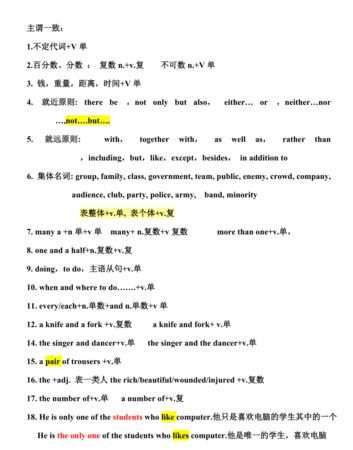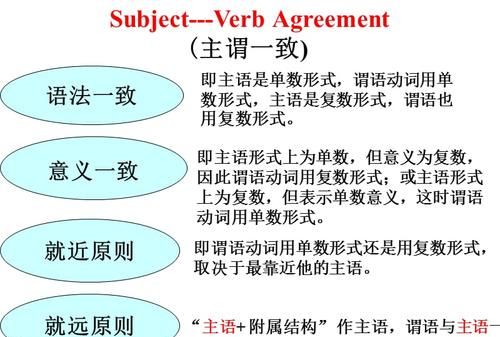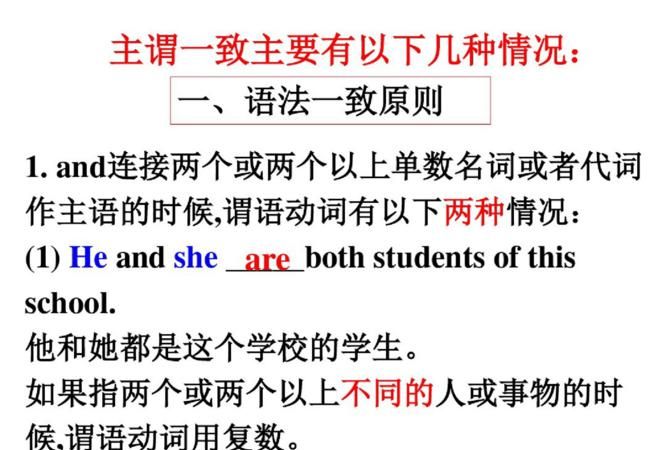本文目录
高考英语主谓一致真题
除了知识和学问之外,世上没有其他任何力量能在人们的精神和心灵中,在人的思想、想象、见解和信仰中建立起统治和权威。下面我给大家分享一些高考英语主谓一致知识,希望能够帮助大家,欢迎阅读!
高考英语主谓一致知识1
(一) 语法一致原则
即主语为单数,谓语用单数,主语为复数,谓语也用复数. 以下为注意事项:
1. 单数主语即使后面带有with , along with, together with, like(象), but (除了),except, besides, as well as, no less than, rather than(而不是), including, in addition to 引导的 短语 , 谓语动词仍用单数.
如: Air as well as water is matter. 空气和水都是物质.
No one except two servants was late for the dinner. 除了两个仆人外, 没有一个人迟来用餐。
2. 用and连接的并列主语,如果主语是同一个人,同一事,同一概念, 谓语动词用单数, 否则用复数. 如:
The poet and writer has come. 那位诗人兼作家来了.(一个人)
A hammer and a saw are useful tools. 锤子和锯都是有用的工具. (两样物)用and连接的成对名词习惯上被看成是一个整体,
如:bread and butter(黄油抹面包), knife and fork(刀叉)等作主语时, 谓语动词用单数。
3. 不定式(短语), 动名词(短语), 或从句作主语时, 谓语动词用单数.
如:
Serving the people is my great happiness.
为人民服务是我的幸福.
When we’ll go out for an outing has been decided.
我们什么时候出去郊游已决定了。
4. 用连接的并列主语被each, every 或no修饰时, 谓语动词用单数.
Every boy and every girl likes to go swimming. 每个男孩和每个女孩都喜欢去 游泳 .
No teacher and no student was absent from the meeting. 没有老师也没有学生开会缺席.
Each man and (each) woman is asked to help. 每个男人和每个女人都被请去帮忙。
5. each of + 复数代词, 谓语动词用单数. 复数代词+each, 谓语动词用单数.
如:Each of us has something to say. 我们每个人都有话要说。
6. 若主语中有more than one 或many a/an , 尽管从意义上看是复数, 但它的谓语动词仍用单数。
但more+复数名词+than one做主语时, 谓语动词仍用复数. 如:
Many a boy likes playing basketball. 许多男生都喜欢打 篮球 .
More than one student was late. 不只一个学生迟到
More persons than one come to help us. 不止一个人来帮助我们。
7. none 做主语时,谓语动词可用单数, 也可用复数; 但在代表不可数的东西时总是看作单数,因而谓语动词要用单数. 如:
None of us are (is) perfect. 人无完人。
None of this worries me. 这事一点不使我着急。
8. 名词如: trousers, scissors, clothes, goods, glasses 等作主语时, 谓语动词必须用复数. 如:
His cloothes are good. 但这些名词前若出现 a pair of , 谓语一般用单数.如:
A pair of glasses is on the desk. 桌上有一副眼镜。
9. 形复意单名词如:news ; 以ics 结尾的学科名称如: physics, mathematics, economics; 国名如: the United States; 报纸名如: the New Times; 书名如: Arabian Night <天方夜谈>; 以及The United Nations<联合国> 等作主语时, 谓语动词用单数。
10. “a +名词+and a half “, “one and a half + 名词”, “the number of + 名词” 等作主语时, 谓语动词要用单数. 如:
Only one and a half apples is left on the table.
注意: one or two + 复数名词作主语, 谓语动词用复数形式, 如:
One or two places have been visited. 参观了一两个地点。
高考英语主谓一致知识2
内容一致原则
1.主语中有all, half, most, the rest等, 以及”分数或百分数+名词”做主语时,谓语动词单复数取决于连用的名词.如:
The rest of the bikes are on sale today. 剩下的自行车, 今天出售。6
0%of the apple was eaten by little boy. 这个苹果的60%都被这个小男孩吃了。
Most of the apples were rotten. 大部分的苹果都是烂的。
Most of the apple was eaten by a rat. 这个苹果的大部分被老鼠吃了。
2. 不定数量的词组, 如:part of , a lot of , lots of , one of , a number of , plenty of等作主语时, 谓语动词的单复数取决于量词后面名词的数.如:
A part of the textbooks have arrived. 一小部分教科书已运到。
A part of the apple has been eaten up by the pig. 这个苹果的一部分被猪吃光了。
3. 加减乘除用单数.如:Fifteen minus five is ten . 15减去5等于10。
4. 表示时间, 金钱, 距离, 度量等的名词做主语时, 尽管是复数形式, 它们做为一个单一的概念时, 其谓语动词用单数.如:
Ten miles is a good distance. 十英里是一个相当的距离。
5. (1) 通常作复数的集体名词. 包括police , people, cattle 等, 这些集体名词通常用作复数.如:The British police have only very limited powers.
(2) 通常作不可数名词的集体名词. 包括equipment, furniture, clothing, luggage 等.
(3) 可作单数也可作复数的集体名词. 包括 audience, committee, government, family, enemy, group, party, team, public 等.如:
The committee has/have decided to dismiss him. 委员会决定解雇他。
6. the +形容词/过去分词形式”表示一类人或事物, 作主语时, 谓语动词用复数.如:
The injured were saved after the fire.
高考英语主谓一致知识3
(三) 就近原则
1. 由here, there, where 等引导的倒装句中, (有时主语不止一个时)谓语动词与靠近它的主语在数上一致.如:
Here comes the bus 公共汽车来了.
Here is a pen and some pieces of paper for you. 给你一支钢笔和几张纸。
Where is your wife and children to stay while you are away? 你不在这儿的时候, 你爱人和孩子在哪儿呆呢?
2. 用连词or, either.... or, neither….nor, not only….but also 等连接的并列主语, 谓语动词与靠近它的主语在数上一致。 如:
Neither the students nor the teacher knows anything about it 学生和老师都不知道这事.
He or you have taken my pen. 他或你拿了我的钢笔。
注意: one of +复数名词+who/that/which 引导的定语从句中, 定语从句的动词为复数。如:
Mary is one of those people who keep pets. 玛丽是 饲养 宠物者之一。
The only one of +复数名词+ who/that./which 引导的定语从句中,定语从句的动词应为单数。
Mary is the only one of those people who keeps pets. 玛丽是一个饲养宠物的人。
高考英语主谓一致知识点相关 文章 :
★ 高中英语语法专题主谓一致与常见短语
★ 主谓一致高中英语语法与短语
★ 高考英语知识点考点归纳
★ 高考英语必考语法知识点汇总
★ 高考英语语法知识点
★ 高考英语知识点汇总大全
★ 高考英语必考语法知识点
★ 2020高考英语必考语法知识点汇总
★ 高考英语必备的语法与知识点
★ 高中英语语法知识点

英语主谓一致三大原则
英语主谓一致使用原则
导语:主谓一致即谓语动词在人称和数上要和主语保持一致,下面我分享英语主谓一致使用原则,欢迎参考!

在英语中,句子的主语和谓语动词在人称和数上必须保持一致,并且大致遵循以下三个原则:
1. 就近一致原则
即句子的谓语动词同最近的主语在人称和数上保持一致。如:
Not you but I am to blame. 不是你而是我应该受责。
Not only you but also your teacher is supposed to go. 不仅你要去,而且你的老师也要去。
2. 语法一致原则
即谓语动词与主语在语法形式上保持一致,即主语是单数形式,动词用单数形式,主语是复数形式,动词用复数形式。如:
The girls are busy packing. 姑娘们在忙着收拾东西。
The last few winters have been very cold. 过去几个冬天都很冷。
Many a student has seen the film. 许多学生看过这部电影。
3. 意义一致原则
即谓语动词的数取决于主语所表示的意义,而不是其语法形式。如:
People are lying on the beach. 人们躺在海滩上。
The steel works is closed for the holidays. 钢厂因放假关门了。
和主语必须在人称和数上保持一致,最基本的原则是:单数主语用单数动词,复数主语用复数动词.但在实际使用当中情况比较复杂,现在学生常犯的主谓一致错误归纳整理如下:
1,"more than one +名词"作主语时,谓语动词常用单数.例如:
More than one teacher gets the flowers. 不止一个教师得到了花.
2,"many a +名词"作主语时,从意义上看是复数,但谓语动词常用单数.例如:
Many a student has been sent to plant trees. 很多学生被派去植树.
3,"half of,the rest of,most of,all of及百分数或分数+of 等后接名词"作主语时,谓语动词形式根据of后的名词而定.例如:
Three fourths of the surface of the earth is covered with water.地球表面四分之三为水所覆盖.
4,all指人时,动词用复数;all指物时,动词用单数.例如:
"All are present and all is going well." 所有人全部到场了,一切进展顺利
5,what引导的主语从句,谓语动词可视表语而定:表语是单数名词时,动词用单数,相反,则用复数.例如:
What they want to get are a number of good books.他们想得到的是大量的好书.
6,and连接的两个单数名词前若用each,every,no修饰,该名词短语作主语时,谓语动词用单数形式.例如:
No book and no pen is found in the schoolbag.书包里没有书和钢笔.
7,当主语后面有as well as,with,along with,together with,but,like,rather than,except,逗号加and连接几个名词等引导的短语时,谓语动词要与最前面的'主语保持一致.例如:
My father as well as his workmates has been to Beijing. 我父亲和他的同事曾去过北京.
8,each作主语的同位语时,谓语动词由主语来决定,与each无关.例如:
They each have a bike. 他们每人有一辆自行车.
9,动词不定式,动词-ing形式短语作主语时,谓语动词常用单数.例如:
Going out for a walk after supper is a good habit.晚饭后出去散步是一个好习惯.
10,the following作主语时,谓语动词的数与后面名词的数保持一致.例如:
The following are good examples
;高中英语主谓一致知识点总结
主谓一致英语句子中,主语的“人称”和“数”要限制,决定谓语动词的形式变化,这就叫“主谓一致”关系。它通常依据三项原则:1)语法一致; 2)意义一致; 3)就近一致。【语法一致原则】I .主语的“人称”决定谓语动词的形式。e.g.①I love / She loves music . 我/ 她爱好音乐。②Are your mother a worker? (误)你母亲是工人吗?Is your mother a worker? (正)(主语your mother 是单数第三人称)II .主语的“数”决定谓语动词的形式。1.“不可数名词、可数名词单数、单数代词、不定式(短语)、动名词(短语)”或“从句”等做主语,用单数谓语形式。e.g.①The work is important . 这项工作重要。②To serve the country is our duty. 为祖国服务是我们的义务。③How and why he left was a sad story. 他离开的经过和原因是一段伤心的经历。2. 复数的名词、代词一般接复数谓语形式。e.g.①The children are taken good care of . 孩子们得到很好的照料。②They have gone to Chengdu . 他们去成都了。III. 以“and”或“both… and”连接的并列主语:1.通常作复数用 。e.g.①Plastics and rubber never rot . 塑料和橡胶从不腐烂。②What he says and what he does do not agree. 他言行不一致。③Both Tom and I are fond of medicine. 我和汤姆都喜欢医学。2. 如果并列主语指的是“同一个”人(事、物、抽象概念),作单数用。e.g.①The worker and writer has come . 这位工人作家来了。②A cart and horse was seen in the distance. 远处能看见有一套马车。③Truth and honesty is the best policy. 真诚是最好的策略。3. “and”前、后的单数词语都有“each, every ,many ,a ,no”等修饰时,仍作单数用。e.g.①Every boy and every girl enjoys equal rights here.这里每个男孩和每个女孩都享有平等权益。②No teacher and no student is excused from taking part in the activity .没有哪个教师或学生可以免于参加这项活动。Ⅳ. 主语前、后加表“数、量”等的修饰语时:1. a)“many a + 单名 ”接单数谓语:“a good (great ) many + 复名”接复数谓语。e.g.①Many a fine man has died for it . 许多优秀战士为此献出了生命。②A great many parents were present at the meeting. 许多家长出席了会议。b)"a / an + 单名+ or two " 大多接单数谓语: "one or two + 复名"接复数谓语。e.g.①Only a word or two is (are )needed. 只需说一两句。②One or two reasons were suggested. 提出一两条理由。c)"a / an + 单名+ and a half"常接单数谓语;“one and a half +复名”多接复数谓语。e.g.①A year and a half has passed . 一年半已过去了。②One and a half tons of rice are sold. 已卖了一吨半大米。d) "more than one + 单名"大多接单数谓语。e.g.①More than one person was (were )absent . 不止一个人缺席。"more + 复名+ than one "接复数谓语。e.g.②More students than one have been there . 不止一个学生去过那儿。"More than two (three…) +复名 " 接复数谓语。e.g.③More than one hundred students have attended the concert . 不止一百名学生听了这场音乐会。2 ,主语前加表示“单位、度量”的短语如“a kind (sort / type / form /pair /cup /glass /piece / load / block / box / handful / quantity / ton / metre /… )of”等时,表示“单位、度量”的这个名词的单复数决定谓语形式。e.g.a)①There is only a small quantity of paper (books ) left . 只剩下少量的纸(书)了。②Large quantities of water are needed. 需要大量的水。b)①This kind of apple is sweet . 这种苹果甜。②This kind of apples is (are) sweet. (大多依 kind ,作单数用 )③These kind(s) of apple(s) are sweet . (总作复数用)但:Apples of this kind are sweet. (总作复数用)3. 主语后接“with…”等构成的短语修饰成分时:谓语仍须与这类短语前的“主语”一致。可构成这类短语的常用“with ,along with ,together with ,as well as , but , besides , except ,added to , including , like ,no less than , rather than , more than ”等。e.g.①A woman with two children has come . 一位妇女带着两个孩子来了。②I as well as they am ready to help you. 不仅他们,我也愿帮助你。4. "one of + 复数名词+ 定语从句":1)定语从句的先行词通常是这个“复数名词”,因此从句的谓语用复数形式。e.g.①This is one of the best novels that have appeared this year . 这是今年出版的最佳小说之一。(关系词“that”代“novels”)②He was one of the boys who were praised . 他是受表扬的男孩之一。2)若“one”前加“this, the ,the only ”等时,定语从句的关系词指代one,作从句主语时,接单数谓语。e.g.He was the only one of the boys who was praised .他是男孩中唯一受到表扬的。(关系词who 代 the only one )【意义一致原则(Notional Concord)】I. 集合名词做主语时:(参见“名词”部分)1. 有些通常作复数用(不变词形)。如:“people , police , cattle (牛,牲口),folk , youth , militia (民兵)”,等。e.g.The police have caught the murderer .警方已捕获凶手。2. 有些指“整体”时作单数,指其中的“成员”时作复数(不变词形)。如 "army , audience(听众),class ,club (俱乐部) ,company(公司), committee(委员会) ,crew ,crowd ,staff(员工) ,family ,public ,government ,group ,party ,union ,couple ,population ,team ."等。e.g.①Our family is a happy one . 我们有个幸福的家庭。②The family are early risers. 这家人都起得早。③The public are (is) requested not to litter. 请公众不要乱扔废弃物。但上述集合名词也可有复数形式。如:families , two classes .等。有些变复数形式后意义不同。如:peoples多个民族。 youths男青年。 folks亲友。II. 代词做主语时:(参见“代词”部分)1. 不定代词"each ,one , much, (a)little ,either ,neither ,another ,the other(+单名)"等常作单数用。它们所修饰的主语也作单数。e.g.①Each of the girls (Each girl) has a new hat . 每个女孩都有顶新帽子。②Neither plan suits me .③Neither of the plans suits / suit me . 两个计划都不适合我。2. 下列复合不定代词一般作单数用:“someone ,somebody ,something ,anybody ,anyone ,anything ,everybody ,everyone ,everything ,nobody ,no one ,nothing ”等。e.g.①Is everybody here ? 都到齐了吗?②There was nothing special then. 那时没什么特别情况。3. 下列不定代词作复数用:“(a)few ,many ,several, both”等。e.g.①Few (of the guests ) were familiar to us . 没几个(客人)是我们熟识的。②Both / Both (of ) these are interesting . 两部影片都有趣。4下列代词须视其“具体所指”来决定单、复数:1)“what ,which ,who ,whose ”等。e.g.①Who is your brother ?你兄弟是谁?②Who are League Members .哪些是团员?2)"all , some ,more ,most ,any ,none ,a lot(of ), lots (of ),"等。e.g.①All (of the students ) are working hard .(所有的学生)都在用功。②All (of the paint ) is fine .(这些油漆)都很好。3)"half(of), plenty (of), the rest(of), (a)part(of), the remainder(of )余下的)",等。e.g.①Half of the apples are bad .苹果中有一半是坏的。②Half of the apple is bad .这只苹果坏了一半。Ⅲ.“数词”、“数量、单位”等词语做主语时:(参见“数词”部分。)1. 表示“运算”的数词通常作单数 。e.g.Ten times four makes(make) forty .+ 乘以四得四十。2.表“时间、距离、金额、度量衡”等的词语,作“整体”看时作单数用,侧重指“若干单位”时作复数用。e.g.①Twenty years is not a long time . 二十年光阴,弹指一挥间。②Twenty years have passed since he left. 他离开已二十个年头了。3.“分数、百分数”通常依其“具体所指”来决定单、复数。e.g.①About 40 percent / two-fifths of the books here are (is) worth reading . 这些书中百分之四十/五分之二值得读。②Only sixty percent / three-fifths of the work was done yesterday .昨天只干完了百分之六十/五分之三的工作。4. "a number of (许多)/ a variety of (各式各样) "+复数名词,常作复数用。e.g.①A number of students in this class are (is) from Sichuan . 这个班有不少同学来自四川。②There are a variety of toys in this shop.这家商店有各种各样的玩具。但是,“the number(数目)/ the variety(种类)”+ of + 复数名词,作单数。e.g.①The number of students in this college has doubled . 这所大学的学生人数翻了一番。②The variety of goods in this shop is rich . 这家商店货物品种丰富。Ⅳ.单、复数同形或易混的词做主语时:(参见“名词”部分)1.以“-ics”结尾的学科名词:指教育、科研的某一学科,作单数。e.g.Mathematics seems easy to me .我似乎觉得数学不难。但是,表“具体的学业、活动”等时,多用作复数。e.g.①Her mathematics are weak . 她数学差。(指“学业成绩、能力”)②What are your politics? 你的政治观点如何?2. “works工厂,means方法,series系列,species物种,aircraft飞机”等名词单、复数同形,要从上下文判断其具体意义来决定单、复数。e.g.①This works was(These works were)built two years ago . 这(几)家工厂是两年前修建的。②Every means has (All means have) been tried. 各种办法都试过了。这类名词通常还有“fish ,deer ,sheep ,headquarters (总部驻地),bellows(风箱), plastics, gallows (绞架), manners(礼貌) ,whereabouts (行踪), ”等。(但news(消息)是不可数名词,通常只作单数用。)Ⅴ. "the + 形容词/分词"做主语时:1. 指“一类”人或事物时,常用作复数用。e.g. ①The English speak English. 英国人讲英语。②The rejected were heaped in the corner. 废品堆在角落里。2.指“某一个”人,或“抽象的”事物时,作单数用。e.g.①The deceased was his father . 去世的是他父亲。②The agreeable is not always the useful. 好看的不一定中用。③The new and progressive always wins over the old. 新生、进步的事物总是要战胜旧的东西。Ⅵ.专用名词做主语时:1.“书名、剧名、报刊名、国家名”等通常作单数用。e.g.①The United States was founded in 1776. 美国成立于1776年。②The Arabian Nights is very interesting. 《天方夜谭》很有趣。2.“书刊名”有时作单数或复数两可,尤其是编成集子的书。e.g.Dickens' American Notes were (was ) published in 1842 .狄更斯所著的《美国笔记》出版于1842年。Ⅶ“what等引导的从句”做主语时:1. 大多作单数用。e.g.①What we need is more practice . 我们需要的是更多的实践。②What he says doesn't agree with what he does. 他言行不一致。2.若从句是含复数意义的并列结构、或“表语”是复数时,谓语动词用单数或复数两可。e.g.①What you say and think is /are no business of mine . 你怎么说以及怎么想,不关我的事。②What he bought was /were some books. 他所买的是几本书。【就近一致原则(Proximity)】也称“邻近原则”,即:谓语与靠近的名词、代词(有时不一定是主语)在“人称、数”上一致。I.在正式文体中:1.由下列词语连接的并列主语:"or; either …or;nor; neither…or;whether…or;not…but; not only…but also" ; 等。e.g.①What he does or what he says does not concern me . 他的行为或言谈都与我无关。②Neither you nor I am wrong. 你和我都没错。③Not you but your father is to blame. 不是你,而是你父亲该受责备。④Not only you hut(also) he is wrong .不仅你错了,他也错了。2. 在倒装句中:谓语可与后面第一个主语一致。e.g.①In the distance was heard the clapping of hands and the shouts of the people . 在远处,能听见鼓掌声和人们的呼喊声。②There is (are) a pen and some books on the desk .桌上有一支钢笔和几本书。II. 非正式文体中:有时依“就近一致原则”,但也可依“意义一致原则”或严格地依“语法一致原则”。e.g.Neither she nor I were there (意义一致) 我和他当时都不在那儿。(非正式)Neither she nor I was there .(就近一致)(译文同上句)(正式)但是,如果依“就近一致原则”而与其他两项原则相矛盾时,则常常认为是不太合符规范的。e.g.No one except his own supporters agree with him .仅他自己的支持者同意他的意见。(依“就近”和“意义”一致的原则;但语法上,“No one ”才是主语,谓语要改成“agrees”。“写作中”一般要依“语法一致”原则。

小学英语语法主谓一致
1 定义
1.1 在英语句子里,谓语受主语支配,其动词必须和主语在人称和数上保持一致,就叫主谓一致。
2 用法三原则
2.1 语法一致原则
2.1.1 主语为单数形式,谓语动词用单数形式;主语为复数形式,谓语动词也用复数形式。如:The number of books he has surprises us all. (主语为单数形式的number) / Jack and I are good friends. (主语为复数形式的Jack and I)
2.2 意义一致原则
2.2.1 主语形式虽为单数,但意义为复数,谓语动词用复数。如:The team are all from South China. (team虽为单数形式,但意指全体队员,所以谓语用复数)
2.2.2 主语形式为复数,而意义上却是单数,谓语动词用单数。如:Physics is his favourite subject. (physics虽为复数形式,但意指物理学科,所以谓语用单数)
2.3 就近原则
2.3.1 谓语动词的单、复数形式取决于最靠近它的词语。如用连词or,either…or, neither…not, not only…but also等连接的并列主语,如果一个是单数,一个是复数,谓语动词与靠近它的主语一致。如:Neither he nor they are able to finish the job on time. / Neither they nor he is able to finish the job on time.
3 代词作主语
3.1 名词性物主代词作主语时,既可以用作单数,也可以用作复数,这取决于它所代替的是单数还是复数。如:Your trousers are black and mine are yellow. / Your pencil is long and mine is short.
3.2 such, the same起指示代词作用时,应根据其所指的内容来决定单、复数。如:Such is his idea. / Such are his words.
3.3 关系代词who, that, which等在定语从句中作主语时,其谓语动词的数应与句中先行词的数一致。如:He who is standing under the tree is my father. / The students who are standing under the tree are from America.
3.4 疑问代词who, what, which作主语时,谓语动词可根据说话人所要表达的意思决定单、复数。如:Which apple do you like? / Which apples do you like?
3.5 不定代词any, either, neither, none, all some, more等作主语时,谓语多用单数。有时也用复数,要看不定代词所指是否为复数。如:All has changed here. / All are present for the meeting now.
4 数词或表量的名词作主语
4.1 “分数或百分数+名词”构成的短语以及由“a lot of, lots of plenty of, a large quantity of, a heap of, heaps of, half of +名词”构成的短语作主语时,其谓语动词要与短语中of后面的名词的数保持一致,这是因为短语中后面的名词是中心词,而短语中前面的量词是修饰语,例如:Lots of deputies will be invited to the conference. / Lots of milk was dumped as waste during the Depression.
4.2 a great deal of只能后接不可数名词,谓语用单数形式。如:A great deal of money has been invested in building the new road.
4.3 表示数量的one and a half后,名词要用复数形式,但是其短语作主语时,谓语动词用单数形式,例如:One and a half teaspoonfuls is just enough for me. 其中,one and a half teaspoonfuls也可以表达为:one teaspoonful and a half。
4.4 a number of(许多)与the number of(...的数量)。两者都是后接可数名词的复数,但前者的谓语用复数形式,后者的谓语用单数形式。如:A number of teachers went on strike yesterday. / The number of the teachers who went on strike yesterday was amazing.
4.5 an amount of(许多)与the amount of(...的数量)。两者只能后接不可数名词,而且谓语都用单数形式。如:An amount of water is wasted every year. / The amount of water which is wasted every year is amazing.
5 名词作主语
5.1 某些集体名词作主语时,如果作为一个整体看待,谓语动词用单数形式,如果就其中一个个成员而言,谓语动词用复数形式。如:The group is a happy one. / The group are on holiday now.
5.2 某些集体名词,如people, police, cattle等,只当复数看待,谓语动词必须用复数。如:The cattle are what they rely on for a living.
5.3 单、复数同形的名词主语时,谓语动词应根据意义决定单、复数。如:A deer is wandering in the bush. / Deer are claimed to be the king's property.
5.4 名词所有格之后的名词被省略,这种情况一般只指商店、工厂、住宅等,作主语时,动词一般用单数。如:The butcher's is just around the corner.
5.5 不定代词each, every, no所修饰的名词即使以and或逗号连接成多主语时,谓语动词仍用单数形式。如:Each boy and each girl wants to go for an outing in the woods.
5.6 一些有两个部分构成的名词表示衣物或工具作主语时,谓语动词通常用复数形式,但如果主语用“a kind of, a pair of , a series of等+名词”构成时,谓语动词一般用单数形式。如:A pair of shoes is a must for everyone.
5.7 当名词词组中心词为表示度量、距离、金额、时间、书名等复数名词时,往往可以根据意义一致的原则,把这些复数名词看作一个整体,谓语用单数形式。如:Five kilometers is a long way to go for school.
5.8 如果主语有more than one…或many a…构成,尽管从意义上看是复数内容,但它的谓语动词仍用单数形式。但是,“more +复数名词+than one”结构之后,谓语动词一般多用复数形式。如:Many a book has been sold out these days. / More books than one have been sold out these days.
5.9 在主谓倒装的句子中,谓语动词的数应与其后的主语一致。如:Between the two rivers lies a small village.
5.10 用and或both…and连接并列主语,谓语动词通常用复数形式。但是,并列主语如果指的是同一个人、同一事物或同一概念时,谓语动词用单数形式,这时and后面的名词没有冠词。如:Jack and Mary are both from France. / A knife and fork is a must for a meal in America.
5.11 当主语后面跟有as well as, as much as, no less than, along with, with, like, rather than, together with, but, except, besides, including, in addition to等引导的词组时,其谓语动词的单、复数由这些单词或短语前的名词或代词的单复数来决定。如:The teacher as well as the students is ready for the trip.
5.12 以or, either…or, neither…nor, not only…but also等连接的名词(代词)作主语时,谓语动词的单复数应根据就近一致的原则。如:Either Tim or his brothers have to water the garden. / Either his brothers or Tim has to water the garden.
6 名词化的形容词或过去分词作主语
6.1 如果主语由“the+形容词(或过去分词)”结构担任时,谓语通常用复数。如:The poor are not inferior to the rich before law.
6.2 少数的过去分词与定冠词连用时指个别,则用单数。如:The departed was a very good neighbour.
7 从句作主语
7.1 由what引导的主语从句,谓语动词通常用单数,但所指的具体内容是复数意义时,谓语动词一般用复数形式,例如:What we need is more fresh water. / What we need are more children's books.
7.2 在“one of+复数名词++who/that/which”引导的从句结构中,关系代词who/that/which的先行词是靠近它的复数名词而不是one,因此,从句中的动词应该是复数形式。但是当one之前有the only等修饰语时,关系代词的先行词是one,而不是靠近它的复数名词,因此从句的动词应是单数形式。如:It is one of the most boring films that have been made. / It is the only one of the films that interests me.

以上就是关于英语主谓一致语法总结,高考英语主谓一致真题的全部内容,以及英语主谓一致语法总结 的相关内容,希望能够帮到您。
